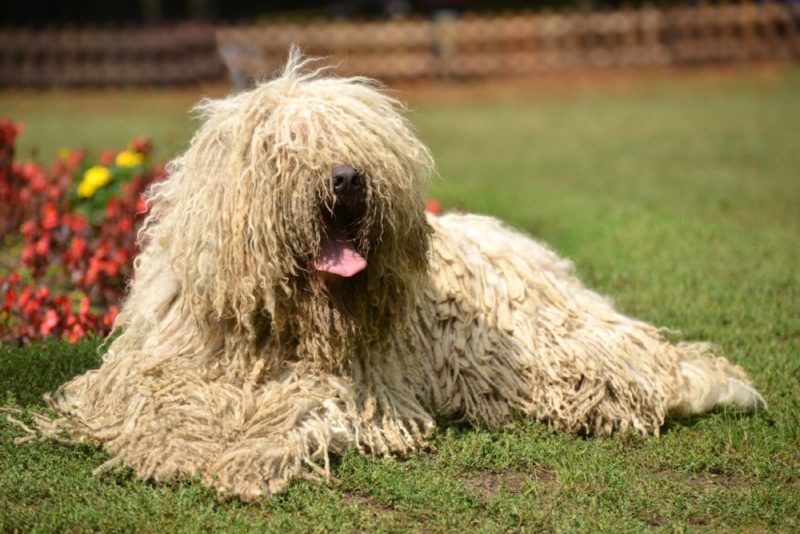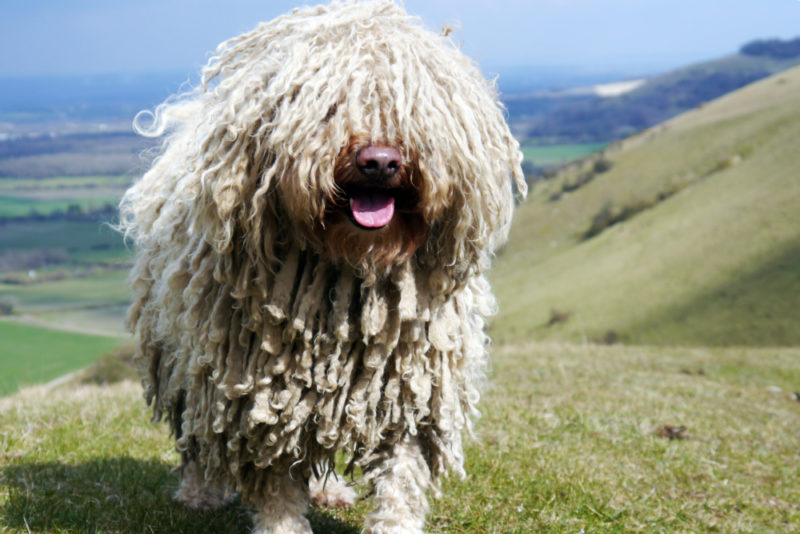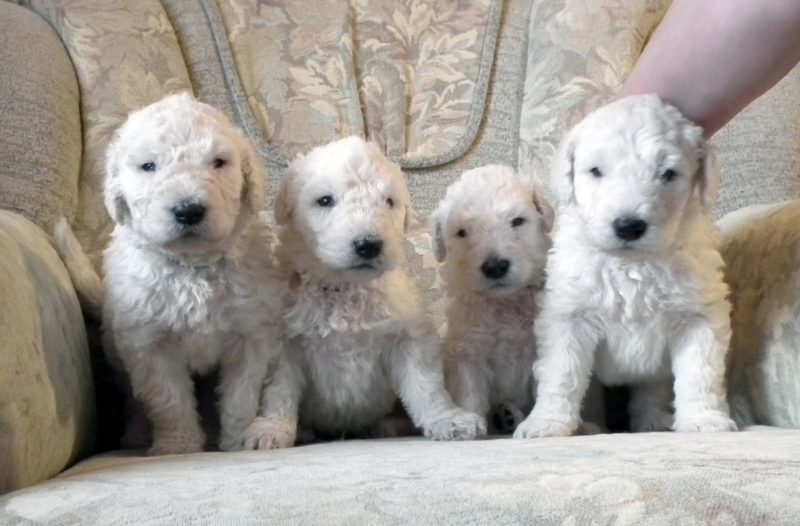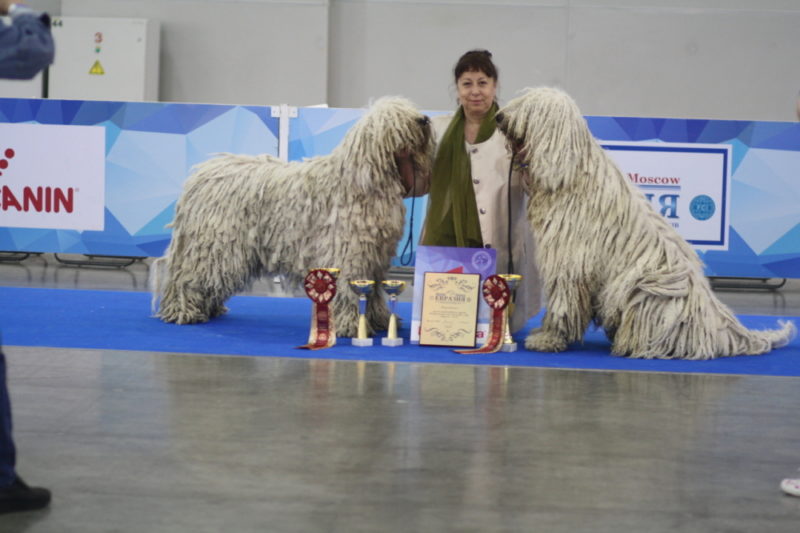There are not many large thoroughbred dogs. However, there is one extremely unusual breed called the Hungarian Shepherd. It will be no less interesting and informative to learn how to care for such dogs, in what conditions it is best to keep them.
Material Content:
Breed description
To begin with, attention should be paid to the description of the breed. Outwardly - this is a large-sized dog with a rather powerful, downed and proportional physique to its large head. Absolutely all overgrown with very thick, long hair, which is somewhat reminiscent of dreadlocks or ribbons. Due to the thick coat on the face, only a black nose can be clearly seen, and the almond-shaped type has dark eyes that are almost completely hidden under woolen dreadlocks. Big ears always hang down, as does the tail. From the side, if you do not look closely, it may even seem that there is no tail at all. In general, when a dog sits, it resembles a large ball of wool without eyes and other parts of the body, only a black nose can be seen.
Note. The dog's size seems visually even larger due to the voluminous coat.
Origin history
There are many diverse opinions about the origin. However, it is reliably known that the dog Komondor hails from Hungary. It is believed that these dogs were introduced into the state by nomads, approximately somewhere in the 7-8th century. Animals were greatly appreciated for their ability to shepherd flocks of sheep. That is why enthusiasts made a lot of efforts to get the perfect shepherd dog out of them.
However, for a long time, this breed was little known outside of Hungary.Only in the 20th century. (1933) its representatives ended up in the United States with the help of Hungarian immigrants who brought them with them. However, the breed was officially introduced and recognized only in 1983.
Because of the Second World War, dogs were threatened with extinction (dogs were actively used in military operations), and the rest, who remained at home, were killed by hunger. However, it so happened that several animals survived in agricultural areas, where the war did not have time to reach, which saved them from extinction.
Nevertheless, now the Hungarian shepherd is considered a rather rare breed. And all because caring for it is required, although simple, but rather thorough, which also takes a lot of effort and time.
The nature and behavior of the Hungarian Shepherd
From the Hungarian shepherds it turns out just a wonderful watchman. However, despite their rather tough disposition, dogs are very attached to their owners. Therefore, they are affectionate with the family, but they don’t like strangers and are always at first hostile towards a stranger. In addition, Komondors are excellent shepherds, since it was laid in them that the flock must be protected, it must not be offended. This is perfect for a family with small children, because the dog will not show aggression or anger towards the baby, you can not be afraid for its safety. But despite this, shepherds categorically do not get along with other animals and do not let dogs, or even cats, enter their territory.
It is best to raise this breed from a young age, then there is a much greater chance of succeeding and raising a pet as it should. The trainer lends itself very well, but if something got into the head of the Komondor, then knocking him off target and making him do something else is almost impossible.
Important! It must be borne in mind that Hungarian shepherds grow up very slowly and behave like puppies for quite some time.
Breed standard and puppy selection
According to the standard established by FCL, the appearance of a Hungarian shepherd is as follows:
- the growth of bitches at the withers is 65-70 cm, and the weight is 40-50 kg, males 75-80 cm and 50-60 kg, respectively;
- wool of a single white color, hairs grow very densely and densely, forming into bundles;
- the head is short with a large wide forehead and deep-set eyes (according to the standard, only brown eyes are allowed), medium-sized ears always look down;
- black nose with wide nostrils, gray lips, teeth - a complete set with a direct bite;
- the body is powerful, well developed, with a wide chest, the dog always keeps his head straight and proud;
- forepaws more powerful than hind legs, elbows not loose;
- the paw pads are solid, gray, and the claws are painted black;
- a long tail with a bend at the end usually hangs down, and when excited, looks up.
Life expectancy is about 9-12 years.
When choosing a pet, you need to pay attention to the following:
- puppies of the Hungarian shepherd must be strong and dense with black eyes and a nose;
- the tail is not docked, otherwise in the future it will be impossible to present the dog at the exhibition;
- puppies with erect ears and bright eyes are considered a breed marriage.
Features of keeping a dog
You can start a Komondor both in the apartment and in a private house. These dogs everywhere feel quite comfortable. But it is important to remember the considerable size of the dog, think carefully before taking it to a small apartment, since such a pet still needs room.
The Hungarian shepherd must have its own separate place, where she could hide from everyone and be alone. It is desirable that this was a small house, just a rug or ottoman is not good. The little puppy must have his own personal toys so that he does not bite and spoil furniture and things.
Also, pets must be walked every day for about an hour, given various physical activities. Otherwise, it may adversely affect the state of health.The dog will become lethargic, lethargic and will sleep a lot.
When keeping a Hungarian in a private house, he can live in a separate booth on the street. But only the home should be large and comfortable for the dog. It is also undesirable to put the Komondor on a chain, otherwise it can greatly “take offense” at the owner and stop perceiving it.
Care, health, feeding
Oddly enough, despite the presence of thick, long hair, which is why the breed was even called the mop dog, it does not require much work to care for the pet.
During walks it is better to dress the dog in a special suit, because his dreadlocks collect dirt and dust very well. It is not necessary to bathe the animal very often, once every 2-3 months is enough. It is imperative to keep the pet dry in a warm place: its coat dries out for a long time, so the dog can catch a cold.
You can trim the dog only if its dreadlocks are already touching the ground and simply interfere. Without special need it is better not to touch anything.
An adult Komondor does not need any combing, it is enough to occasionally separate the bundles of wool manually collected in a lump. But the puppy needs regular separation of the curls with a special brush.
The advantage of the breed is that when molting, the dog’s hair does not fall out, but remains in dreadlocks. Also, the dog does not get an unpleasant smell, even if he sweats or gets wet, which is also a huge plus.
Do not forget to regularly carry out prophylaxis against fleas and ticks to your pet, if necessary, visit a veterinarian. By the way, the health of the breed of the Hungarian Shepherd is very good. She has an unusually strong immunity, rarely gets sick. The only thing that you need to seriously fear is dysplasia of the joints and a defect in the lower eyelid.
As for the nutrition of the animal, there is nothing unusual either. Komondora can be fed with both natural food and purchased food.
Eating natural food:
- lean meat (veal, beef, rabbit);
- any fish (only cleared of large bones);
- prepared cereals (buckwheat, rice, wheat);
- low fat cottage cheese and kefir, yogurt;
- boiled chicken eggs;
- vegetables and fruits, cut into large pieces.
However, when feeding natural food, it is best to entrust the selection of products to a specialist. He will prescribe all the necessary vitamins in order to avoid possible health problems of the pet in the future.
If you decide to feed your dog with purchased food, then you should take only premium food in a sealed package. Komondor needs 1 kg of food per day.
Purpose breed Komondor
Initially, the shaggy shepherd of a Hungarian shepherd was bred in order to accompany and guard the sheep, to ensure that no one dragged the cattle. However, over time, she turned into a wonderful watchman for the property of her master. Komondors are very distrustful, stubborn and stern, so if they let someone unfamiliar into their territory, then it will not be so easy to leave.
Parenting and training
Raise a Hungarian shepherd dog from a young age. You can do the education yourself, but it is better to seek help from a specialist.
In any case, no matter what type of training is chosen, the dog must understand that the owner is the main one and he should obey.
Thanks to mental abilities, Komondors quickly understand teams, but in order to fully teach them everything, you will need to spend a lot of effort and time. This is partly due to the inherent stubbornness of the Hungarians.
It is impossible to give slack, otherwise the dog will consider that it is possible to violate any prohibition on an ongoing basis. However, it is only necessary to raise and train a Hungarian shepherd calmly, affectionately, without raising his voice on the animal. Malice and the manifestation of violence during training will not help, but will only aggravate the situation.When success appears, the animal should be praised or occasionally, when the dog is especially trying, to reward his favorite treat.
It should be noted that with a competent approach, regular and proper upbringing, you can get a great friend and ally from the Komondor who can also always protect his master or his property from ill-wishers.

















